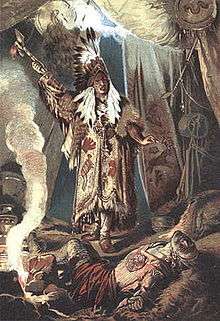Nick of the Woods
Nick of the Woods; or, The Jibbenainesay is an 1837 novel by American author Robert Montgomery Bird. Noted today for its savage depiction of Native Americans, it was Bird's most successful novel and a best-seller at the time of its release.[2]
 1883 illustration from German edition of novel Die Gefahren der Wildnis by Hermann Vogel | |
| Author | Robert Montgomery Bird |
|---|---|
| Country | United States |
| Language | English |
| Publisher | Carey, Lea and Blanchard |
Publication date | March 1837 (United States)[1] |
| Pages | Two vol. (1837 ed.) (240 pg. Vol. I; 246 pg. Vol. II); 1837 English ed. is Vol. I-III |
Publication
The novel was eventually published in twenty-three editions in English, and four translations, including a best-selling German translation by Gustav Höcker.[1][3] The long popularity of the novel is evidenced by the fact that Mark Twain referenced the main character of the book in 1883's Life on the Mississippi, presuming the audience would know the reference.[1][3]
Plot and reception
The novel is set in Kentucky in the 1780s and revolves around the mysterious figure of "Nick of the Woods", dressed as a monster, who seeks to avenge the death of his family by killing numerous Indians, carving a cross on the body of all he slays. "Nick" is revealed to be Nathan Slaughter, a Quaker by day who should by nature and creed avoid all violence. Bird's brutal depiction of Native Americans (the Shawnee) was very hostile, and in part a reaction to the more positive representation of Indians by James Fennimore Cooper in the Leatherstocking Tales.[2][4]
The novel has been called a "prominent example of the American Gothic form."[2] The Columbia Companion to American History on Film, which dubs Nathan Slaughter "a one-man genocide squad", also credits the novel for popularizing the mode of unintelligent Indian speaking ("Me Inju-man! ... Me kill all white man!") used by many later authors and in movies.[5]
Adaptations
The novel was also adapted for the stage in at least three versions, the most popular one by Louisa Medina.[6][7] The Medina version debuted at the Bowery Theatre in New York on February 5, 1838 to great success, although a fire burned down the house after two weeks. It returned to the Bowery in 1839 when it re-opened. The role of Nick became a lifetime starring role for actor Joseph Proctor.[8] In his introduction to Victorian Melodramas (1976), James L. Smith called the play "the most successful American melodrama for more than half a century."[9]
References
- Foust, Clement Edgar. The Life and Dramatic Works of Robert Montgomery Bird (1919), p. 96 (month of publication), p. 155 (Mrs. Bird reports the German translation sold over 10,000 copies; Samuel W. Pennypacker, who was a Governor of Pennsylvania (1903-07), reportedly "sat up all night" reading the book as a child)
- Weinstock, Jeffrey The Ashgate Encyclopedia of Literary and Cinematic Monsters, p. 437 (2014)
- Hart, James D. The Popular Book: A History of America's Literary Taste, p. 80 (1951)
- Lubbers, Klaus. Born for the Shade: Stereotypes of the Native American in United States Literature and the Visual Arts, 1776-1894, pp. 279-82 (1994)
- Rollins, Peter C. (ed.) The Columbia Companion to American History on Film, pp. 277-78 (2003)
- Snodgrass, Mary Ellen. Encyclopedia of Gothic Literature, pp. 27-28 (2005)
- Hall, Roger A. Performing the American Frontier, 1870-1906, p. 29 (2001)
- Bank, Rosemarie K. Theatre Culture in America, 1825-1860, p. 72 (1997)
- Rodriguez, Miriam Lopez (ed.) Women's Contribution to Nineteenth-century American Theatre, p. 35 (2004)
External links
- Nick of the Woods at gutenberg.org
- Nick of the Woods, Vol. I, 1837, Carey, Lea & Blanchard, at archive.org
- Nick of the Woods, Vol. II, 1837, Carey, Lea & Blanchard, at archive.org
- Nick of the Woods, Vol I-III, 1837 (English edition, edited by W. Harrison Ainsworth), at Google Books
- Nick of the Woods. A drama in three acts, Medina play, at Google Books
- Nick of the Woods entry, at Penn Library Exhibition on Robert Montgomery Bird